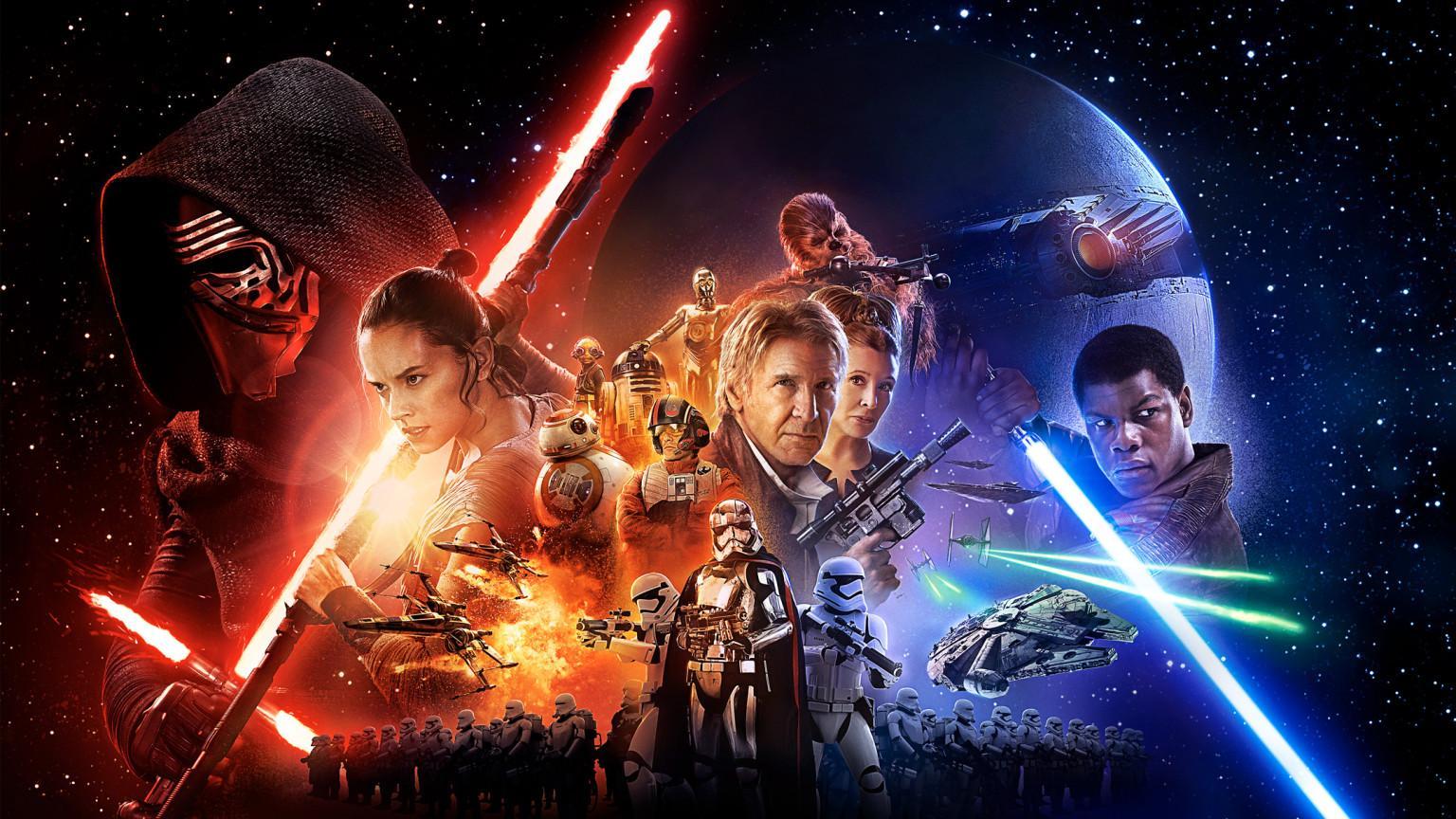Genre Research Activity - Science Fiction
🌟SCIENCE FICTION🌟
🝒 Genre Conventions: Content
Regarding the narrative elements of a sci-film, there is usually a distinct conflict of good vs.evil. The conflicts also commonly have to do with advanced science (hence the name of the genre) and technology (for example: robots and flying cars), human nature, the environment, personal individuality, social organizations and politics, and the power and danger of knowledge. The narrative can also relate to time travel and space.

Star Wars, a science fiction film, shows a distinct conflict of good or evil with the light and dark side, has advanced technology, reflects on social organizations with the rebellion, and is set in outer space.
Settings that are used vary in time, like be set in the past or an alternative present, but is usually set in the future. Some of these films may even be of a prophetic future that presents a likely possible upcoming reality, usually to warn society of the negatives of advancement, especially in technology, and many times showing humanity’s anxiety of its ever-increasing power. Sci-fi films also commonly use the setting of outer space and alternate universes.
Bizzare characters and creatures like aliens and beasts are frequently shown. Characters are memorable and iconic to the film and its story. The main characters are typically put on an extensive and impossible seeming journey to defeat the “evil”. There is normally one main hero of the story, along with sidekicks/companions while they go along their quest as well as one main antagonist that may be a leader of a group.

The alien character in the Alien movies is a strange creature and plays the main antagonist in the movie and is iconic to the film and its franchise.
Frequently, science fiction films may also have narrative elements that reflect on contemporary events and issues of the time the film is being created, such as war and climate change.
🝒 Genre Conventions: Production Techniques
Science fiction films often rely heavily on the most advanced technology film
has to offer to create the best wanted and immersive atmosphere. Because
of this, films frequently take a classicism approach to their production, which
is presented as a middle ground between formalism and realism, showing
an evident fictional story, characters, and universe but presenting it in a way
to make it look like reality.
has to offer to create the best wanted and immersive atmosphere. Because
of this, films frequently take a classicism approach to their production, which
is presented as a middle ground between formalism and realism, showing
an evident fictional story, characters, and universe but presenting it in a way
to make it look like reality.
Sci-fi films, as they focus on showing a fictional universe, use lots of special
effects, both visual (such as CGI) and practical (such as makeup), in order to
make their surreal worlds come to life.
effects, both visual (such as CGI) and practical (such as makeup), in order to
make their surreal worlds come to life.
Star Wars, one of the most beloved science fiction films of all time, utilized lots of practical effects (In the image: Showing the surface of the death star by building a textured surface and showing the battle impacts on a smaller scale) to create the impressive visuals for the time of its creation.
This is an example of CGI from Star Wars. The puppet Yoda made as a practical effect was replaced by a CGI Yoda to create a more realistic portrayal of the character.
To complete the same goal, the production also includes skillful production
design, costume, and art direction to ensure that the endeavor of portraying
the imaginative setting is done successfully. Iconic props that are of advanced
technology is common. The mise en scene makes the imaginative qualities
of sci-fi films come to life.
design, costume, and art direction to ensure that the endeavor of portraying
the imaginative setting is done successfully. Iconic props that are of advanced
technology is common. The mise en scene makes the imaginative qualities
of sci-fi films come to life.
To create unsettling environments, especially in dystopian sci-fi films,
desaturated cool tones are used. Futuristic environments to create a
feeling of sterility often use lots of white. But overall, color can vary upon
different environments attempted to be made.
different environments attempted to be made.
🝒 Institutional Conventions
The target audience for science fiction films can range as science fiction
can touch on a broad topic of subjects that can appeal to everyone.
However, it can vary on the harshness of the story. Some movies such as
Back to the Future and ET, both released in the 1980s, targeted towards
family audiences with light and heartwarming stories. However, the Matrix
can touch on a broad topic of subjects that can appeal to everyone.
However, it can vary on the harshness of the story. Some movies such as
Back to the Future and ET, both released in the 1980s, targeted towards
family audiences with light and heartwarming stories. However, the Matrix
and Alien are targeted towards more mature audiences.
Many science fiction movies have sequels and/or recreations to create a
franchise rather than a single film that can be profitable for a long time.
franchise rather than a single film that can be profitable for a long time.
Because of the lovable and memorable characters of many sci-fi films,
marketing could be focused on the characters. Merchandise of them could
bring in large profits.
marketing could be focused on the characters. Merchandise of them could
bring in large profits.
Modern sci-fi films often use well-known and respected actors and actresses
to sell the story to the people. The main hero/protagonist that they play is
usually in the middle of the movie posters. Iconic imagery from the film, like
advanced technology and inventions, as well as the potential of insight into
the scientific and futuristic setting of the film, may also be shown. This could
encourage the viewer to see the movie by giving a glimpse of the movie’s
story to be told.
to sell the story to the people. The main hero/protagonist that they play is
usually in the middle of the movie posters. Iconic imagery from the film, like
advanced technology and inventions, as well as the potential of insight into
the scientific and futuristic setting of the film, may also be shown. This could
encourage the viewer to see the movie by giving a glimpse of the movie’s
story to be told.
These movies posters promoting the movies Alien and E.T. show iconic iconography from both of the films. Both also show how they are about extraterrestrial alien creatures.
The movie posters for Interstellar and The Martian depict two well-respected actors, Matthew McConaughey and Matt Damon to encourage people to watch the film to watch them.
This poster for Tom Cruise's Oblivion shows a view into the setting of the story, a strangely altered environment.
Marketing is also focused on attracting people through the special immersive, visionary, and otherworldly experience that sci-fi provides.
☾ Une Voyage Dans la Lune ☽
(1902)
George Méliès
(1902)
George Méliès
The director, George Melies is considered to be the “Father of Science Fiction”. The film depicts a story of astronauts on a mission of traveling into space to the moon. Not only does the narrative show advanced technology and science of its time in the ambitious endeavor of going to the moon, but also follows the convention of using the highest film technological advancements at the time and many special effects to create interesting setting transitions and emphasize certain actions. Melies discovered how to do these effects when his camera was dropped and got jammed, accidentally creating a disappearing effect and also used stop motion. Additionally, the fantastical, fictional elements of the imaginative settings on the moon, the personification of the moon, and the odd alien men that the astronauts encounter add to the film fitting into the sci-fi genre. Being a formalist film, the art direction and mise-en-scene were greatly taken account into like most sci-fi films (except sci-fi films, especially modern ones, are mainly classicist).

💫Wall-E 💫
(2008)
Andrew Stanton
The animated Pixar movie, Wall-E, shows a prophetic future of the earth while following the journey of a trash compressing robot. The elements of this film that make it science fiction are being set in a prognostic reality, reflecting on the modern issue of overwhelming waste production, and having advanced technology like the abundance of robots, a large spacecraft, and efficient technological services for the passengers. Like most Sci-fi films, it depicts a lovable protagonist named Wall-E along with an arrangement of memorable companions like his love interest Eve and the humans and robots he befriends on the Axium (the ship). Most of the story also takes place in outer space in the technologically advanced, futuristic setting of the spaceship, common elements of science fiction films.
/cdn.vox-cdn.com/uploads/chorus_image/image/55061015/wall_ecover.0.jpg)
🟄OTHER SCIENCE FICTION FILMS🟄

2001: A Space Odyssey
1968
Stanley Kubrick

Gravity
2013
Alfonso Cuaron
Avatar
2009
James Cameron

District 9
2009
Neill Blomkamp

Star Trek: First Contact
1996
Jonathan Frakes
SOURCES
- 5 Ways to Nail the Sci-Fi Look. (2015, November 18). Retrieved November 14, 2018, from https://www.premiumbeat.com/blog/5-ways-to-nail-the-sci-fi-look/
- Bain, N. (2013, December 01). Science fiction conventions. Retrieved November 14, 2018, from https://www.slideshare.net/Nikchik89/science-fiction-conventions
- Murray, A. (2016, January 30). Sci-fi Target Audiences. Retrieved from https://www.slideshare.net/AndrewMurray53/scifi-target-audiences
- Parkes, M. (n.d.). Science-Fiction-Cinema-Booklet-Day-Course[PDF].
- Parkes, M. (2014, December 09). Science Fiction Cinema Part Three. Retrieved November 14, 2018, from https://prezi.com/cxgiaq_rq88l/science-fiction-cinema-part-three/?utm_campaign=share&utm_medium=copy
- Realism / Formalism / Classicism. (n.d.). Retrieved November 14, 2018, from http://www.prettygoodfilms.com/realismformalism.html
- Revolvy, L. (n.d.). "Outline of science fiction" on Revolvy.com. Retrieved November 14, 2018, from https://www.revolvy.com/page/Outline-of-science-fiction
- What Are Special Effects? The Different Types Of Special Effects in Film. (n.d.). Retrieved November 14, 2018, from https://zoomdune.com/what-are-special-effects-the-different-types-of-special-effects-in-film/
- Film Genres: Science fiction. (n.d.). Retrieved November 14, 2018, from https://researchguides.dartmouth.edu/filmgenres/scifi
- Clapp, J. (n.d.). Science Fiction Film Genre[Pptx].